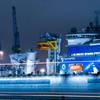After a career leading the modernization of U.S. ship and submarine technology, Dr. William B. Morgan, Head of the Carderock Division's Hydromechanics Directorate, is retiring December 30th with almost fifty years of service. During his career, the Iowa native brought computers into naval engineering, revolutionizing propeller design by shifting from empirical to theoretical, becoming the first in the world to put the theoretical propeller data into a computer. This dramatically reduced propeller noise, enhancing submarine and ship acoustic characteristics. For example, he and his associates developed the highly skewed propeller with its superior vibration and acoustic properties. His largely unheralded work helped the United States win the Cold War.
Dr. Morgan started working with the UNIVAC I and UNIVAC II computers as early as 1954 when programmers punched in data using binary systems. "It used to take me six weeks to perform some theoretical calculations by hand on paper. UNIVAC I cut the time to 25 minutes. Now, those same calculations are made by computers in microseconds. Faster calculations accelerated the use of theory by increasing data that could be included."
Dr. Morgan ends his career managing three hundred expert federal employees, a $70 million budget and Navy testing facilities estimated at almost $2 billion nationwide. He directed the acquisition of world-class facilities such as the Maneuvering and Seakeeping Basin, Rotating Arm, 36-in. Variable Pressure Water Tunnel and the Large Cavitation Channel (LCC). The latter constitutes a testing capability without equal anywhere on Earth. Today, his staff leads the world advancing the state-of-the-art in laser imaging velocimetry, a non-intrusive measurement capability.
Dr. Morgan has published many significant reports describing his accomplishments with sub-cavitating, super-cavitating, contra-rotating propellers and highly skewed propellers; annular airfoil and ducted propeller theory; propeller blade strength; hydrodynamic properties of blade sections; and propeller cavitation, ventilation and noise. He received many awards from national and international technical societies, academia and the Navy. He is the only U.S. citizen to receive the William Froude Medal from the U.K.'s Royal Institute of Naval Architects.
On December 8th, Dr. Morgan was presented with the Department of the Navy Distinguished Civilian Service Award in a ceremony at the Carderock Headquarters in Bethesda. This singular recognition constitutes the highest honorary award the Secretary of the Navy bestows. Complementing this Navy decoration, the Navy has authorized naming the LCC in Memphis and a road at Carderock after Dr. Morgan.
The Carderock Division is the largest, most comprehensive establishment of its kind in the world. The Division provides research, development, test and evaluation, fleet support and in-service engineering for surface and undersea vehicle hull, mechanical and electrical systems and propulsors, and logistics research and development to the Navy and Department of Defense.The Division is chartered by law to support the Maritime Administration and the maritime industry.
The Division employs 3,800 civilian employees and 30 military personnel with most located at two major sites -- the Headquarters in Bethesda, Maryland and the Ship Systems Engineering Station in Philadelphia, Pennsylvania.
Featured videos

Tracking Foreign Vessels Working in the U.S. Jones Act Market

Inmarsat Enhances Service to Drive Digitalization

Inside the Electrified Truckable Tug
Subscribe for
Maritime Reporter E-News
Maritime Reporter E-News is the maritime industry's largest circulation and most authoritative ENews Service, delivered to your Email five times per week









